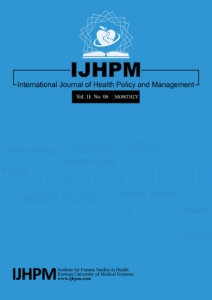Economic inequality in eye care utilization and its determinants: a Blinder-Oaxaca decomposition
Authors
Affiliations
1Center for Health Related Social and Behavioral Sciences Research, Shahroud University of Medical Sciences, Shahroud, Iran.
2Department of Epidemiology and Biostatistics, School of Public Health, Tehran University of Medical Sciences, Tehran, Iran.
3Department of Epidemiology and Biostatistics, School of Public Health, Tehran University of Medical Sciences, Tehran, Iran. ; Knowledge Utilization Research Center (KURC), Tehran University of Medical Sciences, Tehran, Iran.
4Department of Community Medicine, School of Medicine, Tehran University of Medical Sciences, Tehran, Iran.
5Noor Ophthalmology Research Center, Noor Eye Hospital, Tehran, Iran. ; Farabi Eye Hospital, School of Medicine, Tehran University of Medical Sciences, Tehran, Iran.
Abstract
Background: The current study aimed to determine eye care utilization, to assess the role of economic inequality in the utilization of eye care services, and to identify its determinants in Shahroud, North of Iran.
Methods: Of the 6,311 invited people, 5,190 (82.24%) individuals aged 40 to 64 years old participated in the study. A history of a visit by an ophthalmologist or optometrist was considered as eye care utilization. The gap between low- and high-economic groups was decomposed into its determinants using the Oaxaca decomposition method.
Results: Among the participants, 16.32% [95% Confidence Intervals (CI)= 15.31-17.33%] had never been examined by an ophthalmologist or optometrist, and 30.94% (95% CI= 29.69-32.20%) had not undergone an eye examination in the past 5 years. This negative history was significantly higher among female subjects [Odds Ratio (OR)= 1.79, 95% CI= 1.51-2.14], the low-economic group (OR= 2.33, 95% CI= 1.90-2.87), the visually impaired (OR= 1.41, 95% CI= 1.05-1.90), and the uninsured (OR= 1.93, 95% CI= 1.45-2.58). The negative history of eye examination decreased with increasing in age (OR= 0.94, 95% CI= 0.93-0.96) and education (OR= 0.94, 95% CI= 0.92-0.96). In this study, 24.72% (95% CI= 22.30-27.14) of the low-economic group and 9.94% (95% CI= 8.75-11.14) of the high-economic group had no history of eye examination. Decomposition of the gap between the two economic groups showed that education and gender were the most important determinants of inequality.
Conclusion: A considerable percentage of adults, even those with visual impairment, do not receive appropriate eye care. There is a definite economic inequality in the community for which poverty per se could be the major cause.
Keywords: Eye; Health Status Disparities; Inequality; Iran.

